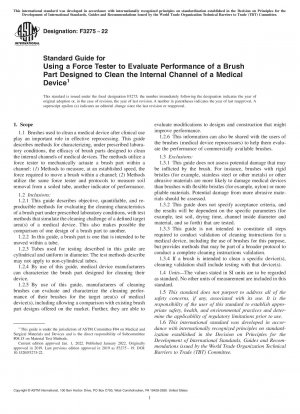ASTM F3275-22
Standard Guide for Using a Force Tester to Evaluate Performance of a Brush Part Designed to Clean the Internal Channel of a Medical Device
- Standard No.
- ASTM F3275-22
- Release Date
- 2022
- Published By
- American Society for Testing and Materials (ASTM)
- Latest
- ASTM F3275-22
- Scope
- 1.1 Brushes used to clean a medical device after clinical use play an important role in effective reprocessing. This guide describes methods for characterizing, under prescribed laboratory conditions, the efficacy of brush parts designed to clean the internal channels of medical devices. The methods utilize a force tester to mechanically actuate a brush part within a channel: (1) Methods to measure, at an established speed, the force required to move a brush within a channel; (2) Methods utilize the same force tester and protocols to measure soil removal from a soiled tube, another indicator of performance. 1.2 Inclusions: 1.2.1 This guide describes objective, quantifiable, and reproducible methods for evaluating the cleaning characteristics of a brush part under prescribed laboratory conditions, with test methods that simulate the cleaning challenge of a defined target area(s) of a medical device. This also makes possible the comparison of one design of a brush part to another. 1.2.2 In this guide, a brush part is one that is intended to be moved within a tube. 1.2.3 Tubes used for testing described in this guide are cylindrical and uniform in diameter. The test methods describe may not apply to non-cylindrical tubes. 1.2.4 By use of this guide, medical device manufacturers can characterize the brush part designed for cleaning their device. 1.2.5 By use of this guide, manufacturers of cleaning brushes can evaluate and characterize the cleaning performance of their brushes for the target area(s) of medical device(s), including allowing a comparison with existing brush part designs offered on the market. Further, they are able to evaluate modifications to designs and construction that might improve performance. 1.2.6 This information can also be shared with the users of the brushes (medical device reprocessors) to help them evaluate the performance of commercially available brushes. 1.3 Exclusions: 1.3.1 This guide does not assess potential damage that may be inflicted by the brush. For instance, brushes with rigid bristles (for example, stainless steel or other metals) or other abrasive materials are more likely to damage medical devices than brushes with flexible bristles (for example, nylon) or more pliable materials. Potential damage from more abrasive materials should be assessed. 1.3.2 This guide does not specify acceptance criteria, and the results will be dependent on the specific parameters (for example, test soil, drying time, channel inside diameter and material, and so forth) that are tested. 1.3.3 This guide is not intended to constitute all steps required to conduct validation of cleaning instructions for a medical device, including the use of brushes for this purpose, but provides methods that may be part of a broader protocol to conduct a complete cleaning instructions validation. 1.3.4 If a brush is intended to clean a specific device(s), cleaning validation shall include testing with that device(s). 1.4 Units—The values stated in SI units are to be regarded as standard. No other units of measurement are included in this standard. 1.5 This standard does not purport to address all of the safety concerns, if any, associated with its use. It is the responsibility of the user of this standard to establish appropriate safety, health, and environmental practices and determine the applicability of regulatory limitations prior to use. 1.6 This international standard was developed in accordance with internationally recognized principles on standardization established in the Decision on Principles for the Development of International Standards, Guides and Recommendations issued by the World Trade Organization Technical Barriers to Trade (TBT) Committee. 1 This guide is under the jurisdiction of ASTM Committee F04 on Medical and Surgical Materials and Devices and is the direct responsibility of Subcommittee F04.15 on Material Test Methods. Current edition approved Jan. 1, 2022. Published January 2022. Originally approved in 2019. Last previous edition approved in 2019 as F3275 – 19. DOI: 10.1520/F3275-22. Copyright © ASTM International, 100 Barr Harbor Drive, PO Box C700, West Conshohocken, PA 19428-2959. United States This international standard was developed in accordance with internationally recognized principles on standardization established in the Decision on Principles for the Development of International Standards, Guides and Recommendations issued by the World Trade Organization Technical Barriers to Trade (TBT) Committee. 1 2. Referenced Documents
ASTM F3275-22 Referenced Document
- ASTM F3208 Standard Guide for Selecting Test Soils for Validation of Cleaning Methods for Reusable Medical Devices
- ISO 15883-1 Washer-disinfectors — Part 1: General requirements, terms and definitions and tests AMENDMENT 1
- ISO 17664 Processing of health care products - Information to be provided by the medical device manufacturer for the processing of medical devices
- ISO/TS 15883-5 Washer-disinfectors - Part 5: Test soils and methods for demonstrating cleaning efficacy
ASTM F3275-22 history
- 2022 ASTM F3275-22 Standard Guide for Using a Force Tester to Evaluate Performance of a Brush Part Designed to Clean the Internal Channel of a Medical Device
- 2019 ASTM F3275-19 Standard Guide for Using a Force Tester to Evaluate Performance of a Brush Part Designed to Clean the Internal Channel of a Medical Device
